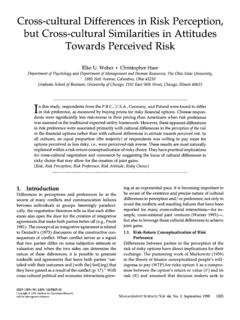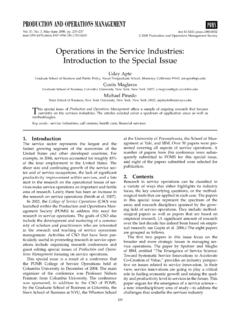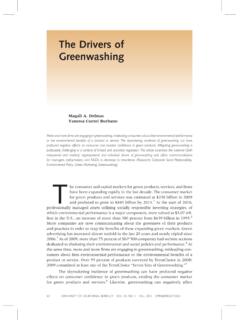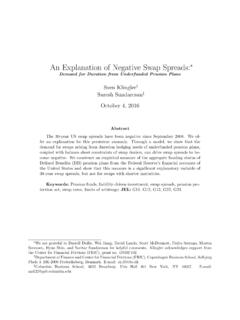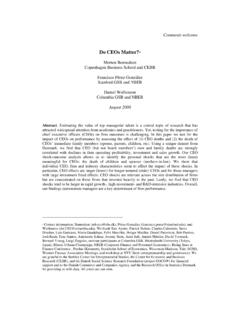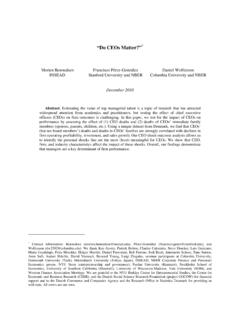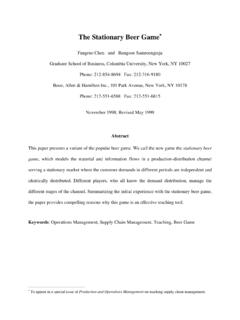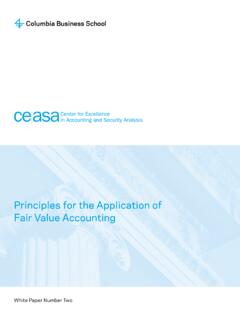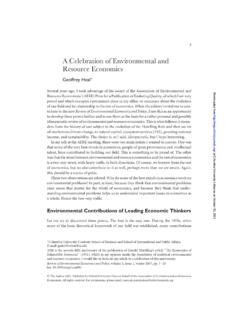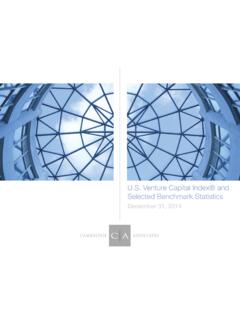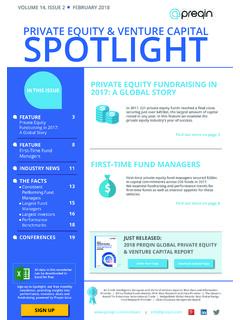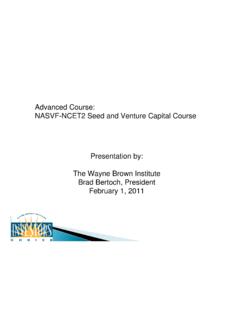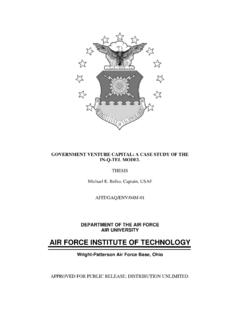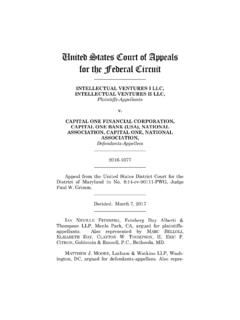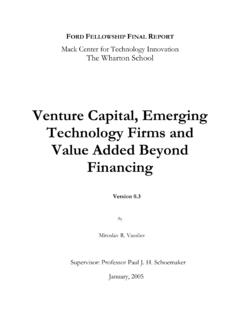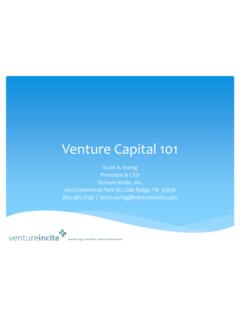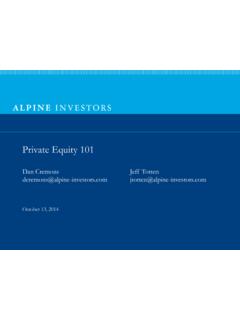Transcription of The Price of Diversi fiable Risk in Venture Capital and ...
1 The Price of Diversifiable Risk in VentureCapital and Private EquityCharles M. JonesGraduate School of BusinessColumbia UniversityTelephone: : Rhodes-Kropf Graduate School of BusinessColumbia UniversityTelephone: : Version July 2004 First Version November 2001 JEL: G24, D82, G31 We thank Larry Glosten, Alex Ljungqvist, Steve Kaplan, Mike Riordan, Tano Santos, Antoinette Schoar,Per Stromberg, S. Viswanathan and participants at the 2003 American Finance Association meeting, theNYSE-Stanford conference on Entrepreneurial Finance and IPOs, the Yale conference on Entrepreneurship,VC and IPOs, and the New York University conference on Entrepreneurship, VC and IPOs for their are grateful to The Eugene M.
2 Lang Entrepreneurship Center forfinancial support. Special thanks go toJesse Reyes and Thomson Venture Economics, who provided the data. All errors are our Price of Diversifiable Risk in VC and PrivateEquityABSTRACTThis paper explores the private equity and Venture Capital (VC) markets and extends thestandard principal-agent problem between the investors and Venture capitalist to show how italters the interaction between the Venture capitalist and the entrepreneur. Since the investor-VC contract is set before the VCfinds any investments, we show that it is the entrepreneurwho must compensate the Venture capitalist for any extra risk in the project even thoughit is the investor who requires the VC to hold the risk and even though the entrepreneurholds all of the market power in the model.
3 Furthermore, although perfectly competitiveinvestors expect zero alpha in equilibrium, the nature of the three way interaction results ina correlation between total risk and investor returns even net of fees. Thus, we show how andwhy diversifiable risk should be priced in VC deals even though investors are fully then take our theory to a unique data set and show that while investors do earn zero alphaon average there is a strong correlation between realized risk and investor returns, exactly aspredicted by the Price of Diversifiable Risk in VC and PrivateEquityVenture capitalists (often called VCs) are known to use high discount rates in assessingpotential investments.
4 This may just be a fudge factor that offsets optimistic entrepreneurialprojections, but VCs claim to use high discount rates even in internal projections. Further-more, Cochrane (2004) looks at individual VC projects and shows that they are surprisinglyprofitable, and earn large positive alphas. In general, VCs seem overly concerned with totalrisk, especially considering that fund investors are well diversified. Why?This paper answers this question with a novel theory that links the principal-agent problemto asset prices, with empirical tests of the theory on newly available Venture fund data.
5 Ourtheory extends the principal-agent problem to interactions between the agent and a third partyand demonstrates the impact of this extension in the Venture Capital arena. The principal-agent problem between an investor and a Venture capitalist alters the interaction betweenthe Venture capitalist and the entrepreneur. We show that it is theentrepreneurwho mustcompensate the Venture capitalist for the extra risk that theinvestorrequires the VCs tohold, even though the entrepreneur holds all of the market power in the model. Furthermore,although perfectly competitive investors expect zero alpha in equilibrium, the nature of thethree-way interaction results in a correlation between total risk and average return even netof fees.
6 Thus, we show that diversifiableriskcanbepricedinVCdeals,ev eniftheoutsideinvestors are fully then take our theory to a unique data set and show that while investors do earnzero alpha on average as expected, there is a strong correlation between realized risk andinvestor returns, exactly as predicted by the model: the quartile of VC funds with the greatestidiosyncratic risk has an alpha of per quarter, while the lowest quartile has a per quarteralpha of trade-offbetween risk and incentives is a classic feature of contracts. Much of thework on this aspect of the principal-agent problem has focused on either the optimal contract(for example see Holmstrom and Weiss (1985) or Holmstrom and Milgrom (1987)) or on theattempt to see the resulting trade-offs empirically (see Prendergast (1999) for a recent survey).
7 In this paper, our main contribution is to examine both theoretically and empirically the effectof the principal-agent problem on equilibrium asset prices. The VC market is the ideal arena1to examine the economic significance of the principal-agent problem. The investing principalsare legally barred from actively monitoring their VC agents, so the principal-agent problemshould be a central concern. Thus, if the principal-agent problem, a staple of economic theory,is fundamental it should have a large impact on the VC bring the principal-agent problem to asset prices we develop a simple yet novel basic setting is that the private equity and Venture Capital markets are characterized byentrepreneurs with ideas, and outside investors who are well-diversified, but have little abil-ity to screen and manage potential investments.
8 Investors hire VCs who have considerableexpertise in assessing and overseeing entrepreneurial VCs have little capitalof their own, so they are in essence money managers, helping investors supervise their in-vestments. Because of standard incentive problems, VCs receive an interest in thefirms theyfund. They are unable to monetize their holdings and are instead forced to hold a substantialamount of their wealth in the form of these contingent stakes. Furthermore, significant timeis required to oversee an investment, which means that a VC can manage only a few invest-ments.
9 This means that VCs hold considerable idiosyncratic risk and must be compensatedfor bearing this standard principal-agent problem ends here. If VCs were simply compensated by theprincipal for the services they provide and the risk they bear, then fund returns net of VC fees,earned by well-diversified investors, would be uncorrelated with idiosyncratic risk. Investorswould compete away excess returns, resulting in zero net this paper, we go one step further, studying the impact of the investor-VC problem onnegotiations between the VC and the entrepreneur.
10 The sequencing is key. VCs and investorsstrike their bargainfirst. The contract that exposes the VC to (and compensates the VC for)the risk of the portfolio is set before the VC actually locates any projects. Thus, the investor-VC contract is designed to compensate the VC for the expected risk in the portfolio, not therealized risk. It is not possible to contract on realized risk both because it is unverifiablebut also because, at least in the , laws governing the investor-VC relationship require the1 For example, the average entrepreneurial idea may have a negative NPV if not guided correctly, but theVC eliminates projects with the least potential and manages the others to success, making the average VCproject NPV is important to distinguish between gross returns on VC investments and net returns to investors.
